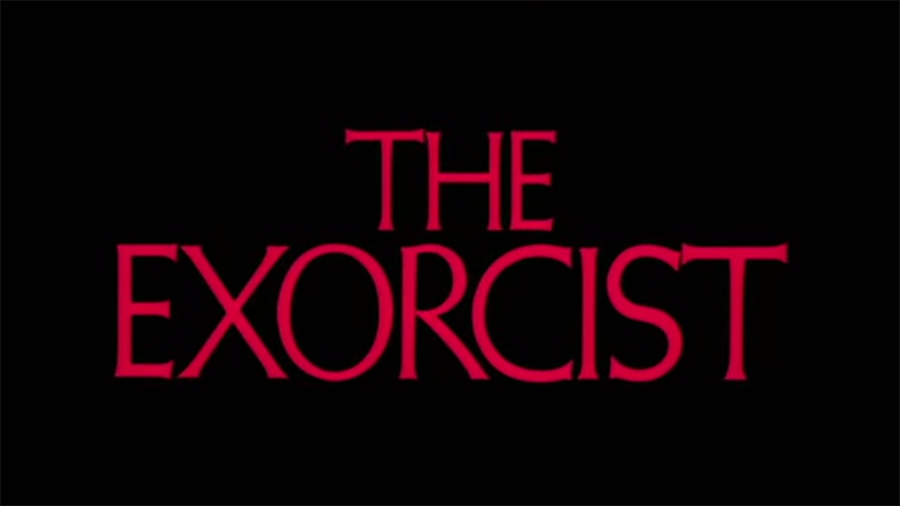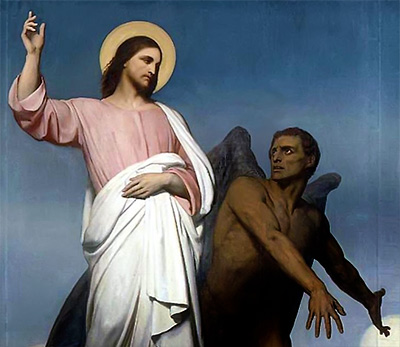The Devil You Know
An obsession with Satan and exorcism can have the effect of domesticating both.
Forty-three years ago, a film burst onto screens that would elevate a drive-in-movie genre to art status and scare the Hell out of audiences worldwide: The Exorcist, based on the bestselling novel by William Peter Blatty and directed by French Connection helmsman William Friedkin, went on to become the second-highest grossing film of 1973, and garner 10 Oscar nominations and two statues.

YouTube/MovieTitleScreens
The story in short: Regan (Linda Blair) is 12 and having psychological “issues.” Single mom Chris MacNeil (Ellen Burstyn) goes the allopathic route, subjecting her to a battery of tests, but comes up empty. It’s not until Regan kills mom’s boyfriend by throwing him against a wall that she calls a priest. And so it begins, a days’-long adventure in which a wise old man (Max von Sydow) is killed and another sacrifices himself to purge the devil from this poor tormented child. From spinning Regan’s head 360 degrees to toxic vomit to levitation, the devil puts on quite a horrifying (and in one startling scene, obscene) show. In the end, however, owing to one priest’s Christ-like substitution, peace is restored to Regan’s soul.
What is more terrifying than the thought that exorcism, which traditionally has been a literally awesome aspect of Christian baptism, is now a “path” of self-possession.
Friedkin’s style elevated the ghoul flick to a masterwork of dark art. Blatty, whose story was informed by a real exorcism, would win an Oscar for Best Screenplay. Dick Smith, the makeup magician whose work before then had included Brando’s aging face in The Godfather, went on to solidify his reputation as one of the all-time greasepaint greats.

YouTube/BestMovieClips
The popularity of the possession subgenre has ebbed and flowed but never gone away — this fall, FOX has revived The Exorcist as a television series — although other “possession” films have never quite hit the celebratory heights enjoyed by The Exorcist. The Exorcism of Emily Rose is perhaps the best of the bunch, also based on a true story. And as Martin Luther liked to say, the devil can’t stand being laughed at: so parodies naturally followed, including Possessed, starring Leslie Nielsen, the Airplane and Naked Gun master of the deadpan. More recently, we’ve seen the smart and profitable The Conjuring and its sequel, both starring Vera Farmiga and based on the true-life stories of husband-and-wife paranormal investigators Ed and Lorraine Warren.
How can we explain this ongoing fascination with not just the supernatural — vampires, zombies, ghosts and such — but with “possession”? Is it merely because cinematic special effects can give the devil his due?
I mean, who even believes in the devil anymore?
Well, the late Supreme Court Justice Antonin Scalia, for one. In an interview with New York magazine, Scalia defended the legitimacy of such belief, and took umbrage at his interlocutor’s apparent incredulity.
Isn’t it terribly frightening to believe in the Devil?
You’re looking at me as though I’m weird. My God! Are you so out of touch with most of America, most of which believes in the Devil? I mean, Jesus Christ believed in the Devil! It’s in the Gospels! You travel in circles that are so, so removed from mainstream America that you are appalled that anybody would believe in the Devil! Most of mankind has believed in the Devil, for all of history. Many more intelligent people than you or me have believed in the Devil.
I hope you weren’t sensing contempt from me. It wasn’t your belief that surprised me so much as how boldly you expressed it.
I was offended by that. I really was.

The Temptation of Christ by Ary Scheffer – Wikimedia Commons
Scalia is right about those numbers. In fact, a majority of Americans, 57 percent in fact, believe in a literal devil. And why shouldn’t they? The majority religion in the United States remains Christianity, and throughout its history, orthodoxy has taught that Satan, the devil, the Enemy, is a literal personal spirit who has been given a temporary reign in this world but whose end is foretold by Christ himself.
So-called progressives, including the Christian variety, have relegated such a belief to a prescientific grappling with mental illness and terrifying phenomena such as seizures or paralysis. And yet a scientistic worldview has failed to rid a great many of belief in a literal devil. One is tempted to say it has multiplied them. Didn’t Romanticism follow on the Enlightenment, gothic horror on Voltaire and Paine (with perhaps De Sade as the link between them)?
In his 2001 book, American Exorcism, admitted “skeptic” Michael W. Cuneo attended and dissected exorcisms around the world and wrote up a dispassionate report. Exorcism would seem to be a most American pastime, to hear him tell it, because at its root is a peculiarly, even poignantly, American obsession: personal transformation.
What surprised Cuneo was not just how ubiquitous the practice of exorcism was, among Protestants and Catholics, clergy and laity, but also what he discerned was the nagging need it seemed to meet. “Whatever one’s personal problem — depression, anxiety, substance addiction, or even a runaway sexual appetite — there are exorcism ministries available today that will happily claim expertise for dealing with it.”
What should be an occasion for genuine spiritual dread and self-examination before the dominion of radical Evil is thus alchemized into rituals of “self-empowerment” and Hollywood-mediated spectacles of cut-rate catharsis (if I “experience” vicariously the very worst thing that can happen, it won’t!).
In a sense, an obsession with Satan has had the effect of domesticating him. And what is more terrifying than the thought that exorcism, which traditionally has been a literally awesome aspect of Christian baptism, is now a “path” of self-possession.
So what has become of the author who sparked this diabolical rage? For the past four years at least, William Peter Blatty, a devout Catholic, has been facing off against a new enemy: Georgetown, his alma mater. Blatty is exercised over the defenestration of the Catholic orthodoxy that once echoed through its halls. I would quote from the petition that he submitted to the Vatican, but it’s 200 or so pages long, with 476 footnotes, and I doubt a précis would do justice to its concerns. The devil, as we all know, is in the details.







